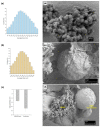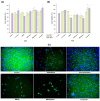Comparison between the Astaxanthin Release Profile of Mesoporous Bioactive Glass Nanoparticles (MBGNs) and Poly(3-hydroxybutyrate- co-3-hydroxyvalerate) (PHBV)/MBGN Composite Microspheres
- PMID: 37299231
- PMCID: PMC10255251
- DOI: 10.3390/polym15112432
Comparison between the Astaxanthin Release Profile of Mesoporous Bioactive Glass Nanoparticles (MBGNs) and Poly(3-hydroxybutyrate- co-3-hydroxyvalerate) (PHBV)/MBGN Composite Microspheres
Abstract
In recent years, composite biomaterials have attracted attention for drug delivery applications due to the possibility of combining desired properties of their components. However, some functional characteristics, such as their drug release efficiency and likely side effects, are still unexplored. In this regard, controlled tuning of the drug release kinetic via the precise design of a composite particle system is still of high importance for many biomedical applications. This objective can be properly fulfilled through the combination of different biomaterials with unequal release rates, such as mesoporous bioactive glass nanoparticles (MBGN) and poly(3-hydroxybutyrate-co-3-hydroxyvalerate) (PHBV) microspheres. In this work, MBGNs and PHBV-MBGN microspheres, both loaded with Astaxanthin (ASX), were synthesised and compared in terms of ASX release kinetic, ASX entrapment efficiency, and cell viability. Moreover, the correlation of the release kinetic to phytotherapeutic efficiency and side effects was established. Interestingly, there were significant differences between the ASX release kinetic of the developed systems, and cell viability differed accordingly after 72 h. Both particle carriers effectively delivered ASX, though the composite microspheres exhibited a more prolonged release profile with sustained cytocompatibility. The release behaviour could be fine-tuned by adjusting the MBGN content in the composite particles. Comparatively, the composite particles induced a different release effect, implying their potential for sustained drug delivery applications.
Keywords: Astaxanthin; composite microspheres; controlled release; sustained release.
Conflict of interest statement
The authors declare no conflict of interest.
Figures





Similar articles
-
Fabrication and Characterization of Cinnamaldehyde-Loaded Mesoporous Bioactive Glass Nanoparticles/PHBV-Based Microspheres for Preventing Bacterial Infection and Promoting Bone Tissue Regeneration.Polymers (Basel). 2021 May 29;13(11):1794. doi: 10.3390/polym13111794. Polymers (Basel). 2021. PMID: 34072334 Free PMC article.
-
Integration of Mesoporous Bioactive Glass Nanoparticles and Curcumin into PHBV Microspheres as Biocompatible Composite for Drug Delivery Applications.Molecules. 2021 May 26;26(11):3177. doi: 10.3390/molecules26113177. Molecules. 2021. PMID: 34073377 Free PMC article.
-
Toward Highly Dispersed Mesoporous Bioactive Glass Nanoparticles With High Cu Concentration Using Cu/Ascorbic Acid Complex as Precursor.Front Chem. 2019 Jul 16;7:497. doi: 10.3389/fchem.2019.00497. eCollection 2019. Front Chem. 2019. PMID: 31380344 Free PMC article.
-
In vitro neuronal and glial response to magnetically stimulated piezoelectric poly(hydroxybutyrate-co-hydroxyvalerate) (PHBV)/cobalt ferrite (CFO) microspheres.Biomater Adv. 2024 May;159:213798. doi: 10.1016/j.bioadv.2024.213798. Epub 2024 Feb 10. Biomater Adv. 2024. PMID: 38364446
-
Zn-Mn-Doped Mesoporous Bioactive Glass Nanoparticle-Loaded Zein Coatings for Bioactive and Antibacterial Orthopedic Implants.J Funct Biomater. 2022 Jul 16;13(3):97. doi: 10.3390/jfb13030097. J Funct Biomater. 2022. PMID: 35893465 Free PMC article.
Cited by
-
Characteristics of Microparticles Based on Resorbable Polyhydroxyalkanoates Loaded with Antibacterial and Cytostatic Drugs.Int J Mol Sci. 2023 Oct 7;24(19):14983. doi: 10.3390/ijms241914983. Int J Mol Sci. 2023. PMID: 37834429 Free PMC article.
References
Grants and funding
LinkOut - more resources
Full Text Sources

